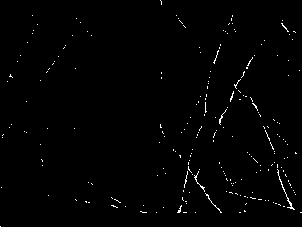Method for manufacturing zinc oxide-cellulose nanocrystalline composite fiber film with antibacterial characteristic and photocatalytic degradation characteristic at same time
A cellulose nanocrystalline, composite fiber membrane technology, applied in fiber processing, fiber chemical characteristics, rayon manufacturing, etc., can solve the problem of poor mechanical properties, breaking strength, low Young's modulus, and poor polymer orientation of PHBV fibers. Improve and other problems, to achieve high-efficiency photocatalytic degradation characteristics, enhance mechanical and thermal properties, and solve the effect of poor interfacial compatibility
- Summary
- Abstract
- Description
- Claims
- Application Information
AI Technical Summary
Problems solved by technology
Method used
Image
Examples
Embodiment 1
[0029] Mix the mixed acid solution of microcrystalline cellulose, hydrochloric acid and citric acid at a solid-to-liquid ratio of 1:50, wherein the volume ratio of citric acid to hydrochloric acid is 9:1, react at 70°C for 6 hours, and use 3mol / The pH of the solution was adjusted to 7 with L ammonia water, washed with water, centrifuged, and freeze-dried to obtain CNC powder. Disperse the CNC powder in distilled water to obtain a CNC suspension with a mass fraction of 3%, mix it with a 0.5 mol / L zinc nitrate hexahydrate aqueous solution, and slowly add a 1 mol / L sodium hydroxide solution dropwise under stirring conditions at 70 °C. After the addition, the solution was reacted for 20 minutes under stirring, washed with water, centrifuged, and then freeze-dried to obtain a CNC-ZnO hybrid material. Add CNC-ZnO and PHBV to the N,N-dimethylformamide solution, raise the temperature to 50°C, and stir thoroughly to obtain a transparent and uniform electrospinning solution. Electrospi...
Embodiment 2
[0031] Mix the mixed acid solution of microcrystalline cellulose, sulfuric acid and citric acid at a solid-to-liquid ratio of 1:40, wherein the volume ratio of citric acid to sulfuric acid is 8:1, react at 80°C for 7 hours, and use 8mol / The solution was neutralized with L potassium hydroxide to a pH of 7, washed by centrifugation and then freeze-dried to obtain CNC powder. Disperse the CNC powder in distilled water to obtain a CNC suspension with a mass fraction of 1%, mix it with a 1mol / L zinc sulfate aqueous solution, and slowly add a 2mol / L sodium hydroxide solution dropwise under stirring conditions at a temperature of 80°C. After the sodium hydroxide solution was finished, the solution was reacted for 15 minutes under stirring conditions, centrifuged, washed with water, and then freeze-dried to obtain CNC-ZnO. Add CNC-ZnO and PHBV to the chloroform solution, raise the temperature to 60°C, and stir thoroughly to obtain a transparent and uniform electrospinning solution. T...
Embodiment 3
[0033] Mix the mixed acid solution of microcrystalline cellulose, hydrochloric acid and citric acid at a solid-to-liquid ratio of 1:70, wherein the volume ratio of citric acid to hydrochloric acid is 10:1, react at 60°C for 8 hours, and use 7mol / The solution was neutralized with L sodium carbonate to a pH of 7, centrifuged, washed with water, and freeze-dried to obtain CNC powder. Disperse the CNC powder in distilled water to obtain a CNC suspension with a mass fraction of 2%, mix it with an aqueous solution of 1mol / L zinc chloride, and slowly add 0.5mol / L sodium hydroxide solution dropwise under stirring conditions at a temperature of 60°C. After the sodium hydroxide solution was added, the solution was reacted for 30 minutes under stirring conditions, centrifuged, washed with water, and then freeze-dried to obtain CNC-ZnO. After adding CNC-ZnO and PHBV to the tetrahydrofuran solution, raise the temperature to 70°C, and stir thoroughly to obtain a transparent and uniform ele...
PUM
| Property | Measurement | Unit |
|---|---|---|
| diameter | aaaaa | aaaaa |
| length | aaaaa | aaaaa |
| diameter | aaaaa | aaaaa |
Abstract
Description
Claims
Application Information
 Login to View More
Login to View More - R&D
- Intellectual Property
- Life Sciences
- Materials
- Tech Scout
- Unparalleled Data Quality
- Higher Quality Content
- 60% Fewer Hallucinations
Browse by: Latest US Patents, China's latest patents, Technical Efficacy Thesaurus, Application Domain, Technology Topic, Popular Technical Reports.
© 2025 PatSnap. All rights reserved.Legal|Privacy policy|Modern Slavery Act Transparency Statement|Sitemap|About US| Contact US: help@patsnap.com



